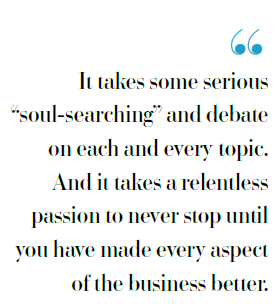How focusing on fundamentals can revitalize your company’s business and culture
I know, I know.
Another article on getting “back to basics.”
You’ve heard it all before. Which is exactly the point.
The basics are…basic.
Yet, they are overlooked and forgotten more than any of us want to admit.
Over my time in this channel, 33 years and counting, I’ve had the tremendous opportunity to work with all types of companies. Pre-start up, start up, growth, global giants and companies on the decline.
I love the rocket ride of rapid growth. It’s fun. It’s crazy. It provides its own type of addiction. And—it doesn’t last.
At some point, a company that has grown rapidly has to face the fact that everything isn’t all rosy. Growth covers up a lot of flaws. It allows us to make a lot of mistakes and not even notice them—or at least, not focus on them for very long. Things are good.
I’ve said this before, and although not universal, I’ve seen companies go from $0-$100 million on brute force and charisma. But, there comes a time where those companies have to become a well-run business. A business with sound strategy and solid execution. The right people doing the right things right.
Coming Back from the Edge
Over the past few years, it seems I’ve stumbled into an area that I really enjoy—working with people who have achieved great success but are struggling, declining or on the verge of slowing their growth. The indicators are there, and it’s only a matter of time.

What I’ve learned is that these companies tend to have a few things in common. They lost sight of or never understood the basics of the business. They didn’t build an organization that is designed to look ahead and drive toward a common goal with a sustainable and measurable plan.
Something isn’t right. The people. The processes. The execution and accountability. The overall strategy. Something.
Where do we begin?
First, admit you have a challenge. Then, decide what you want to do about it.
Often, making big changes requires big changes to the mindset and beliefs of your team. For most companies, we recommend looking very closely at the culture. Don’t confuse culture with HR—it’s much more than that. Culture is the culmination of a lot of things—it clearly begins with the people. Their beliefs, their communications, their alignment. But it extends into operational excellence and technologies as well. Technology??? Yes, technology is either the great enabler or the great roadblock to almost everything you do.
A good culture can handle and implement change effectively. A bad culture can kill change before it even starts.
As odd as it may sound, if you are serious about creating a great field leadership, start with your internal corporate leadership. Your field knows what is going on in the home office. They can feel it if things are not “right.” They know when key team members are out of their element or less than qualified for the job. They know when your staff isn’t happy or is overly stressed. You are not hiding anything from them. So, focus on making it right at home.
Commit to creating the culture you want. You can’t be another company, so stop trying. Be the best company you can be. Be different. Be special. Be something and someone your people believe in and are willing to fight for.
If you make the decision about what you want to create, be relentless in your effort to achieve it. Make sure your decisions are leading there. Provide the tools, processes and training that help your people to get there, too.
Putting in the Work
Over the past few years, I’ve worked closely with a company who had had challenges, to put it politely. Their field had lost trust in their decision-making and follow through. They didn’t believe the company would execute fully on almost any idea they came up with. And, as a result, the complaints were rolling in. The CEO was overwhelmed with calls, emails and texts from disgruntled distributors. It was daunting.
Working closely with the CEO and executive team, we focused on creating a different culture. One where the people inside the company could provide ideas and solutions and get them done. We worked on empowering people and providing the tools, training and confidence they needed. We wanted them to identify and resolve problems without asking for permission. Just fix it!

Because it involved every department in the company, we started by working to make the customer experience extraordinary. They told the distributors that they were on a mission to make their experience better. They put a stake in the ground and committed to making it happen. No excuses!
They asked questions and listened, identifying the challenges and perceived roadblocks standing in the way of success. They worked on making deliveries better. They made dramatic advances in outbound communications to better manage and deliver on expectations. They worked on technology to make the ordering process better and easier. They made the first experience for the new customer extraordinary and provided incentives to gather feedback from every customer. They created a new way of communicating with field leadership to bridge any gaps that may have existed.
And more. Much more.
None of those things, alone, would have made a significant impact. In fact, none of them, alone, were very difficult to do. It took a collective willingness and commitment to “get it done” and a person inside the company to create a forum of accountability and communication.

Over the course of just a few months, a funny thing happened. Their people, inside the company, started to believe they could make a difference. And then they did. They took control of the problems and made their customers (both retail and distributors) happy.
The customers and distributors felt it. Something changed. They couldn’t really put their finger on it, but things felt different—things felt better.
Then, the CEO looked up one day and said to me that he didn’t recall the last time he had received a call from a disgruntled distributor. They had stopped complaining. They believed in the company again. They were happy.
It all started with a focus on the internal team.
Ok, so now you have a higher-performing, engaged and happier team…Now what?
This is where the real work (and fun) begins.
Alignment. Change. Belief.
We have found that it is important to create true alignment with your executive team. Things have changed but have all the people changed too? Have they altered their belief in the organization? Are they leading from this new perspective? Face it, companies who have been around for years or, perhaps, decades, have people on the team who tend to see the business through a specific lens. Perhaps, they even see it at a specific point in time—“the good old days.” Those team members, who we love and value for all of their contributions, can be the most stubborn when it comes to change.
Personal and professional development is crucial in order to manage change. The same beliefs and skills will not deliver new results. This effort begins with the executive level but should extend throughout the organization.
Be very intentional when it comes to developing your team. Make sure the tools and training you provide align clearly with the outcomes you are trying to deliver to the company, the people and the shareholders.
Because knowledge and insight into the nuances and intricacies of our channel is so important—and, at times, so hard to come by—I strongly recommend allocating resources to the development of that knowledge within your corporate team. Resources like DSN’s Membership Program can provide a wealth of outstanding industry content and expertise to all your employees. It’s not all you need but it is a “cheat code” when it comes to learning industry-specific ideas. Onboarding and teaching best practices in our industry is now at our fingertips.
Outside resources can be a tremendous asset when it comes to developing your team and creating the alignment needed to reach the next level. If you are willing, there are experts who can help with topics ranging from marketing/branding, alignment/communications, execution and so much more.
The truth is, once you get to the point where you have accountability and alignment, there will be a number of other areas that must be addressed. These include:

- Simplifying your processes
- Mission/Vision/Values
- Branding/Messaging
- Product strategy
- Compensation strategies
- Customer obsession
- Optimizing execution
- Communication strategies
- Technologies
- Field enablement
- And more
It takes time to do it right. It takes the right people with the right expertise. It takes some serious “soul-searching” and debate on each and every topic. And it takes a relentless passion to never stop until you have made every aspect of the business better.
Going back to basics is hard but, by doing them a step at a time, anyone can make it happen. Be disciplined and know that the effort to focus on the fundamentals is worth it.
Paul Adams has been involved in the direct selling channel for more than 30 years. Over the decades, he has worked with hundreds of companies and been a trusted advisor in boardrooms with countless executive teams. From corporate giants to pre-startup, Paul has helped companies invent, reinvent and solidify their messaging, strategy and execution.
From the February 2022 issue of Direct Selling News magazine.


